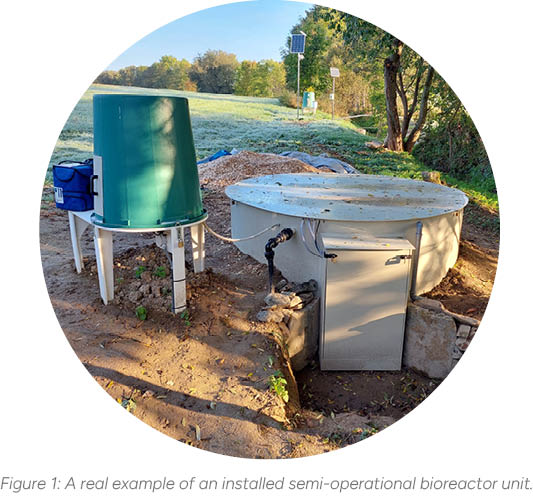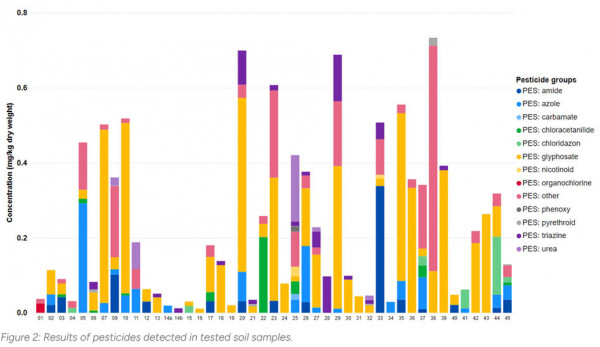Protecting Drinking Water Sources with Bioreactors: An Innovative Solution to the Problem of Pesticides in the Landscape
Published: May 2024
Download PDF
EnviroMail_17_Europe_Protecting Drinking Water Sources with Bioreactors: An Innovative Solution to the Problem of Pesticides in the Landscape

Intensive farming, even when good agricultural practices are followed, very often results in pesticide contamination of soil, surface water and groundwater. Water sources used for drinking water production are thus often affected. The outcome is the progressive banning of proven, effective, yet persistent pesticides in the environment, alongside a decline in water quality. This, in turn, results in substantial investments in water treatment technologies to ensure that drinking water meets relevant legal standards. Passive, easy to maintain and low-cost in-situ denitrification woodchip bioreactors might be a solution to this situation. These bioreactors have already been successfully used in some countries (e.g. the USA) to remove other types of agricultural pollution directly at the point of origin, thus preventing its further transport in the environment.
Nitrates and Denitrifying Bioreactors
Denitrifying woodchip bioreactors are a relatively simple containerised treatment technology originally intended for the removal of nitrates from agricultural outflows. They use woodchip media as a source of bioavailable organic carbon to promote denitrification, which converts nitrates to gaseous nitrogen, the predominant natural component of the atmosphere. The advantages of using denitrification woodchip bioreactors are low acquisition and operating costs, minimal maintenance, long lifetime, and low land take. At some sites, these bioreactors have been operated for more than 15 years without major interventions and with the original fill and still achieve high denitrification rates.
ALS Research Project
To verify the usability of denitrifying woodchip bioreactors for the simultaneous removal of both nitrates and pesticides found in surface runoff from agriculturally active areas is the goal of research project "Comprehensive assessment of soil contamination with pesticides and in-situ remediation leading to eliminate their entry into groundwater“. The project is being realised under the leadership of ALS Laboratories in cooperation with other research institutes. Work on the project will continue until 2025.
Semi-operational Unit and Expected Pesticides Removal
Previous research projects by ALS and their partners have thoroughly mapped and identified sites that have been, in terms of pesticides occurrence, problematic for a long time. A semi-operational unit of the denitrification woodchip bioreactor described above was commissioned at one of these sites in the autumn of 2023.
The unit uses poplar wood chips as a feedstock, which have proven well for this purpose, and is equipped with automatic samplers, sensors measuring basic physical and chemical parameters and a data station with on-line data transmission.
In the case of pesticides, several decontamination mechanisms are envisaged in the bioreactor area, the most important of which will be the sorption and microbial decomposition. The aim of the project
is to suggest the operating conditions of the bioreactor in such a way that the natural processes of microbial degradation of pesticides are facilitated to the maximum extent possible, or to support these processes by active intervention in the physicochemical composition of the bioreactor and its microflora.
Related EnviroMail_08_Europe: Hidden Pesticide Threats in Protected Landscape Areas

Case Study: Monitoring of Pesticides in Soil Samples from Central Europe
In June 2023, monitoring of pesticides in agricultural soils and surrounding surface waters was conducted from 45 sites across Central Europe. The range of deter-mined targeted substances was based on prepared risk analysis taking into account the consumption of pesticides and their risk properties such as toxicity and persistence. Analytical methods based on liquid chromatography coupled to tandem mass spectrometry (UPLC-MS/MS) were used to determine a wide range of active pesticide substances and their metabolites (308 and 352 parameters, respectively). Results are summarized in Figure 2.
Pesticides were detected in all collected soil samples ranging from 0.01 to 0.73 mg/kg DW (dry weight of soil). By far the most abundant group was glyphosate pesticides, i.e. the herbicide glyphosate and especially its metabolite AMPA (Aminomethylphosponic acid), its total concentrations ranged from 0.01 to 0.46 mg/kg DW in 36 of the 45 samples collected and tested. Comparing to levels and incidence of pesticides within the Europe, glyphosate and AMPA belong to the most frequently detected and those with the highest concentrations pesticide compounds generally.
In related surface water samples, pesticides were detec-ted in 43 out of 45 tested samples, their concentrations ranged from 0.01 μg/L to 14.1 μg/L. The most abundant pesticides detected were chloracetanilide and glyphosate.
Protective Measures in the Landscape
Based on the results obtained during the testing of the semi-operational denitrification woodchip bioreactor unit, a linear measure will be designed and properly sized for the model catchment to remove pesticides directly at the point of generation and thus prevent their further spread.
EU legislation
- SOIL: Proposal COM(2023) 416 final of 5 July 2023 for a directive of the European Parliament and of the Council on Soil Monitoring and Resilience (Soil Monitoring Law).
- SURFACE WATER: Directive 2008/105/EC of the European Parliament and of the Council of 16 December 2008 on environmental quality standards in the field of water policy, amending and subsequently repealing Council Directives 82/176/EEC, 83/513/EEC, 84/156/EEC, 84/491/EEC, 86/280/EEC and amending Directive 2000/60/EC of the European Parliament and of the Council.
- GROUND WATER: Directive 2006/118/EC of the European Parliament and of the Council of 12 December 2006 on the protection of groundwater against pollution and deterioration.
- DRINKING WATER: Directive (EU) 2020/2184 of the European Parliament and of the Council of 16 December 2020 on the quality of water intended for human consumption (recast).
References
- Schipper et al. (2010). Denitrifying bioreactors – Anapproach for reducing nitrate loads to receiving waters.Ecological Engineering, 36: 1532–1543. DOI: Z0.1016/j.ecoleng.2010.04.008.
- Vieira, D., Franco, A., De Medici, D., Martin Jimenez,J., Wojda, P., Jones, A.: Pesticides residues in Europeanagricultural soils – Results from LUCAS 2018 soil module.Publications Office of the European Union,Luxembourg, 2023. DOI:10.2760/86566, JRC133940.


